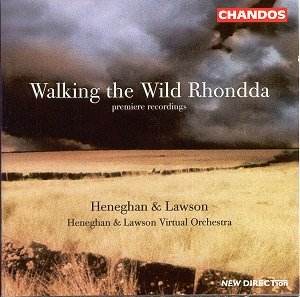Ben Heneghan and Ian Lawson have been working as a
composer partnership since 1980. You will have heard their music for
various television programmes. Perhaps the most famous is the catchy
music for the children's animation Fireman Sam (known as Sam
Smalaidh, in Gaelic). Here they each present their own music; none
of this is collegiate except in the execution. The execution is what
marks this CD out as unusual. Instead of an orchestra of musicians re-creating
these pieces from a score with a conductor the performance is computer
created by the two composers. This explains the ‘virtual’ orchestra
reference. More of that later. Now to the music.
Lawson's Four Celtic Fanfares are not
in the English brass tradition of Bliss and Elgar although they are
certainly celebratory in character. The first brims with fiercely flowing,
indefatigable exuberance - part Tippett; part Nyman. The second has
a brassy magnificence and in its appealing melodic content there is
a touch of John Barry. The third seems to inhabit Copland's 'tender
land'. The piece yawns and stretches into a harmonically crunching climax.
The skipping motoric power of the final fanfare reminds me of William
Mathias (in the Dance Overture and the praising sections of Lux
Aeterna and This Worldes Joie). It dissolves into a sky darkened
by rain-heavy clouds which finally burst into four dactyls of lightning.
Ghost Train lacks the urgent life of
the Fanfares but is more moody. The train in question emerges
out of a slow, densely atonal, threnody. It gathers momentum and Arnoldian
colour along the way. At 7.03 a wailing train horn is heard.
The Lawson pieces are instantly accessible to the listener
without being at all facile. The two pieces by Ben Heneghan are somehow
tougher. The House At The North Pole is colourful and attractive
- a playful phantasmagoria. The Rhondda piece (which gives its
name to the album) is named after Joseph Biddulph’s book of the same
name. This is highly atmospheric writing which I sense may reap longer
term rewards from repeat listenings. At this stage all I can do is record
some impressions: the music proceeds warily, passes through assertive
episodes. The sound of pianos trilling away is evocative of wheeling
birds breasting the updrafts from hillsides strewn with terraced houses,
colliery spew, conifers and church halls. In a strange way this mood
picture belongs in the same company as Maurice Johnstone’s Tarn Howes,
Arnold’s Third Cornish Dance and the Manchester Road section
of Hadley’s The Hills.
Chandos have taken a gamble by being the first major
label to issue recordings using a ‘virtual’ orchestra. This simulacrum
of an orchestra is computer synthesised from samples of actual instrument
sounds. The technique has been used widely by composers wanting to showcase
their own writings but this has largely been as a promotional tool.
Chandos have backed these two composers with a commercial release of
music rendered on what amounts to a robot orchestra. The sounds are
idiosyncratic and by no means completely natural. Strings and
woodwind can still sound synthetic but brass textures are quite believable.
However the results are listenable and there is much enjoyment to be
taken from these recordings. Should orchestras look to their laurels?
Not just yet ... but in five years' time ...?
Back to the music … Once you have surmounted any prejudices
against synthesised orchestral sounds you will instantly relate to Lawson’s
rhythmic and melodic power and Heneghan’s way with atmospheric sound-painting.
Rob Barnett
FURTHER INFORMATION
www.heneghanlawson.com

